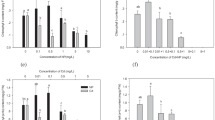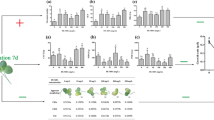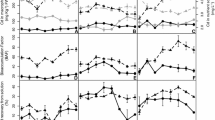Abstract
This study aimed to investigate and compare the effects of exogenous glycinebetaine (GB) and trehalose (TR) on the biological responses of duckweed (Lemna gibba L.) against cadmium (Cd) accumulation. Duckweed samples were exposed to 0.5, 1, and 3 mM of Cd for 6 days in the presence and absence of GB (0.5, 1, 2, and 5 mM) or TR (0.5, 1, 2, and 5 mM). The accumulation of Cd, GB, and TR were investigated, and their influence on the rates of lipid peroxidation, photosynthetic activity, proline content and enzymatic antioxidant performance was examined. Two-way ANOVA showed that exposure to Cd and/or GB or TR caused an increase in Cd accumulation concentration dependently. TR had significant effects on Cd accumulation. The application of 0.5 mM TR increased Cd accumulation, whereas 5 mM decreased Cd accumulation. However, Cd accumulation was not significantly affected by the presence of GB. Cd concentration alone or in combination with GB or TR had a significant effect on lipid peroxidation, photosynthetic activity, proline content, and antioxidant enzyme activities. In addition, statistically significant GB–Cd and TR–Cd interactions were observed. We conclude that both GB and TR play protective roles against Cd stress in aquatic plants. The use of a low level of TR (i.e., 0.5 mM) may be more useful than GB in phytoremediation studies.


Similar content being viewed by others
References
Aravind, P., & Prasad, M. N. V. (2003). Zinc alleviates cadmium-induced oxidative stress in Ceratophyllum demersum L.: a free floating freshwater macrophyte. Plant Physiology and Biochemistry, 41, 391–397.
Arnon, D. I. (1949). Copper enzyme in isolated chloroplast polyphenol oxidase in Beta vulgaris. Plant Physiology, 24, 1–15.
Ashraf, M., & Foolad, M. R. (2007). Roles of glycine betaine and proline in improving plant abiotic stress resistance. Environmental and Experimental Botany, 59, 206–216.
Bae, H., Herman, E., & Sicher, R. (2005). Exogenous trehalose promotes non-structural carbohydrate accumulation and induces chemical detoxification and stress response proteins in Arabidopsis thaliana grown in liquid culture. Plant Science, 168, 1293–1301.
Banu, M. N. A., Hoque, M. A., Watanabe-Sugimoto, M., Matsuoka, K., Nakamura, Y., & Shimoishi, Y. (2009). Proline and glycinebetaine induce antioxidant defense gene expression and suppress cell death in cultured tobacco cells under salt stress. Journal of Plant Physiology, 166, 146–156.
Bates, L. S. (1973). Rapid determination of free proline for water-stress studies. Plant and Soil, 39, 205–207.
Cakmak, I. (2000). Possible roles of zinc in protecting plant cells from damage by reactive oxygen species. The New Phytologist, 146, 185–205.
Cannino, G., Ferruggia, E., Luparello, C., & Rinaldi, A. M. (2009). Cadmium and mitochondria. Mitochondrion, 9, 377–384.
Cao, X., Ma, L. Q., & Tu, C. (2004). Antioxidative responses to arsenic in the arsenic-hyperaccumulator Chinese brake fern (Pteris vittata L.). Environmental Pollution, 128, 317–325.
Cardwell, A. J., Hawker, D. W., & Greenway, M. (2002). Metal accumulation in aquatic macrophytes from southeast Queensland, Australia. Chemosphere, 48, 653–663.
Chen, Y. X., He, Y. F., Luo, Y. M., Yu, Y. L., Lin, Q., & Wong, M. H. (2003). Physiological mechanism of plant roots exposed to cadmium. Chemosphere, 50, 789–793.
Cortina, C., & Culianez-Macia, F. A. (2005). Tomato abiotic stress enhanced tolerance by trehalose biosynthesis. Plant Science, 169, 75–82.
Davis, P. H. (1984). Flora of Turkey and East Aegean Islands vol. 8. Edinburg: Edinburgh University Press.
Demiral, T., & Turkan, I. (2004). Does exogenous glycinebetaine affect antioxidative system of rice seedlings under NaCl treatment? Journal of Plant Physiology, 161, 1089–1100.
Demiral, T., & Turkan, I. (2006). Exogenous glycinebetaine affects growth and proline accumulation and retards senescence in two rice cultivars under NaCl stres. Environmental and Experimental Botany, 56, 72–79.
Dixit, V., Pandey, V., & Shyam, R. (2001). Differential antioxidative responses to cadmium in roots and leaves of pea (Pisum sativum L. cv.Azad). Journal of Experimental Botany, 52, 1101–1109.
Duman, F., Leblebici, Z., & Aksoy, A. (2009). Growth and bioaccumulation characteristics of watercress (Nasturtium officinale R. Br.) exposed to cadmium, cobalt and chromium. Chemical Speciation and Bioavailability, 21, 257–265.
Gancedo, C., & Flores, C. L. (2004). The importance of a functional trehalose biosynthetic pathway for the life of yeasts and fungi. FEMS Yeast Research, 4, 351–359.
Grannopolitis, N., & Ries, K. (1977). SOD occurence in higher plants. Plant Physiology, 59, 309–314.
Haas, J. W. (1986). Complexation of calcium and copper with carbohydrates: implications for seawater speciation. Marine Chemistry, 19, 299–304.
Hall, J. L. (2002). Cellular mechanisms for heavy metal detoxification and tolerance. Journal of Experimental Botany, 53, 1–11.
Harinasut, P., Tsutsui, K., Takabe, T., Nomura, M., Takabe, T., & Kishitani, S. (1996). Exogenous glycinebetaine accumulation and increased salt-tolerance in rice seedlings. Bioscience, Biotechnology, and Biochemistry, 60, 366–368.
Hattori, T., Mitsuya, S., Fujiwara, T., Jagendorf, A. T., & Takabe, T. (2009). Tissue specificity of glycinebetaine synthesis in barley. Plant Science, 176, 112–118.
Heath, R. L., & Packer, L. (1968). Photoperoxidation in isolated chloroplasts kinetics and stoichiometry of fatty acid peroxidation. Archives of Biochemistry and Biophysics, 125, 189–198.
Heuer, B. (2003). Influence of exogenous application of proline and glycinebetaine on growth of salt-stressed tomato plants. Plant Science, 165, 693–699.
Hoque, M. A., Okuma, E., Banu, M. N. A., Nakamura, Y., Shimoishi, Y., & Murata, Y. (2007). Exogenous proline mitigates the detrimental effects of salt stress more than exogenous betaine by increasing antioxidant enzyme activities. Journal of Plant Physiology, 164, 553–561.
Hoque, M. A., Banu, M. N. A., Nakamura, Y., Shimoishi, Y., & Murata, Y. (2008). Proline and glycinebetaine enhance antioxidant defense and methylglyoxal detoxification systems and reduce NaCl-induced damage in cultured tobacco cells. Journal of Plant Physiology, 165, 813–824.
Islam, M. M., Hoque, M. A., Okuma, E., Banu, M. N. A., Shimoishi, Y., Nakamura, Y., et al. (2009). Exogenous proline and glycinebetaine increase antioxidant enzyme activities and confer tolerance to cadmium stress in cultured tobacco cells. Journal of Plant Physiology, 166, 1587–1597.
Islam, M. M., Hoque, M. A., Okuma, E., Jannat, R., Banu, M. N. A., Jahan, S., et al. (2009). Proline and glycinebetaine confer cadmium tolerance on tobacco bright yellow-2 cells by increasing ascorbate-glutathione cycle enzyme activities. Bioscience, Biotechnology, and Biochemistry, 73, 2320–2323.
Khan, I., Ahmad, A., & Iqbal, M. (2009). Modulation of antioxidant defence system for arsenic detoxification in Indian mustard. Ecotoxicology and Environmental Safety, 72, 626–634.
Li, B. Q., Zhou, Z. W., & Tian, S. P. (2008a). Combined effects of endo- and exogenous trehalose on stress tolerance and biocontrol efficacy of two antagonistic yeasts. Biological Control, 46, 187–193.
Li, M., Zhang, L. J., Tao, L., & Li, W. (2008b). Ecophysiological responses of Jussiaea rapens to cadmium exposure. Aquatic Botany, 88, 347–352.
Liang, Y. C., Chen, Q., Liu, Q., Zhang, W. H., & Ding, R. X. (2003). Exogenous silicon (Si) increases antioxidant enzyme activity and reduces lipid peroxidation in roots of salt-stressed barley (Hordeum vulgare L.). Journal of Plant Physiology, 160, 1157–1164.
Luo, Y., Li, W. M., & Wang, W. (2008). Trehalose: protector of antioxidant enzymes or reactive oxygen species scavenger under heat stress? Environmental and Experimental Botany, 63, 378–384.
Ma, Q. Q., Wang, W., Li, Y. H., Li, D. Q., & Zou, Q. (2006). Alleviation of photoinhibition in drought stressed wheat (Triticum aestivum) by foliar applied glycinebetaine. Journal of Plant Physiology, 163, 165–175.
MacKinney, G. (1941). Absorption of light by chlorophyll solutions. The Journal of Biological Chemistry, 140, 315–322.
Mäkelä, P., Jokinen, K., Kontturi, M., Peltonen-Sainio, P., Pehu, E., & Somersalo, S. (1998). Foliar application of glycinebetaine a novel product from sugar beet as an approach to increase tomato yield. Indian Crop Production, 7, 139–148.
Megateli, S., Semsari, S., & Couderchet, M. (2009). Toxicity and removal of heavy metals (cadmium, copper, and zinc) by Lemna gibba. Ecotoxicology and Environmental Safety, 72, 1774–1780.
Mishra, S., Srivastava, S., Tripathi, R. D., Govindarajan, R., Kuriakose, S. V., & Prasad, M. N. V. (2006). Phytochelatin synthesis and response of antioxidants during cadmium stress in Bacopa monnieri L. Plant Physiology and Biochemistry, 44, 25–37.
Mohan, B. S., & Hosetti, B. B. (1997). Potential phytotoxicity of lead and cadmium to Lemna minor grown in sewage stabilization ponds. Environmental Pollution, 98, 233–238.
Nakano, Y., & Asada, K. (1981). Hydrogen peroxide is scavenged by ascorbate-specific peroxidase in spinach chloroplasts. Plant & Cell Physiology, 22, 867–880.
Nery, D. C. M., da Silva, C. G., Mariani, D., Fernandes, P. N., Marcos Pereira, D., Panek, A. D., et al. (2008). The role of trehalose and its transporter in protection against reactive oxygen species. Biochimica et Biophysica Acta, 1780, 1408–1411.
Ngayila, N., Botineau, M., Baudu, M., & Basly, J. P. (2009). Myriophyllum alterniflorum DC. Effect of low concentrations of copper and cadmium on somatic and photosynthetic endpoints: a chemometric approach. Ecological Indicators, 9, 307–312.
Ozden, M., Demirel, U., & Kahraman, A. (2009). Effects of proline on antioxidant system in leaves of grapevine (Vitis vinifera L.) exposed to oxidative stress by H2O2. Scientia Horticulturae, 119, 163–168.
Prasad, M. N. V. (1995). Cadmium toxicity and tolerance in vascular plants. Environmental and Experimental Botany, 35, 525–545.
Prasad, M. N. V., Malec, P., Waloszek, A., Bojko, M., & Strzaka, K. (2001). Physiological responses of Lemna trisulca L. (duckweed) to cadmium and copper bioaccumulation. Plant Science, 161, 881–889.
Razinger, J., Dermastia, M., Koce, J. D., & Zrimec, A. (2008). Oxidative stress in duckweed (Lemna minor L.) caused by short-term cadmium exposure. Environmental Pollution, 153, 687–694.
Rodriguez, M., Taleisnik, E., Lenardon, S., & Lascano, R. (2010). Are Sunflower chlorotic mottle virus infection symptoms modulated by early increases in leaf sugar concentration? Journal of Plant Physiology, 167, 1137–1144.
Sasmaz, A., & Obek, E. (2009). The accumulation of arsenic, uranium, and boron in Lemna gibba L. exposed to secondary effluents. Ecological Engineering, 35, 1564–1567.
Singer, M. A., & Lindquist, S. (1998). Multiple effects of trehalose on protein folding in vitro and in vivo. Molecular Cell, 1, 639–648.
Singh, N., Ma, L. Q., Srivastava, M., & Rathinasabapathi, B. (2006). Metabolic adaptations to arsenic-induced oxidative stress in Pteris vittata L. and Pteris ensiformis L. Plant Science, 170, 274–282.
Siripornadulsil, S., Traina, S., Verma, D. P. S., & Sayre, R. T. (2002). Molecular mechanisms of proline mediated tolerance to toxic heavy metals in transgenic microalgae. The Plant Cell, 14, 2837–2847.
Sivaci, E. R., Sivaci, A., & Sökmen, M. (2004). Biosorption of cadmium by Myriophyllum spicatum L. and Myriophyllum triphyllum orchard. Chemosphere, 56, 1043–1048.
Tomassi, F. (2001). A comparative study of glutathione and ascorbate metabolism during germination of Pinus pinea L. seeds. Journal of Experimental Botany, 52, 1647–1654.
Zhang, F. Q., Wang, Y. S., Lou, Z. P., & Dong, J. D. (2007). Effect of heavy metal stress on antioxidative enzymes and lipid peroxidation in leaves and roots of two mangrove plant seedlings (Kandelia candel and Bruguiera gymnorrhiza). Chemosphere, 67, 44–50.
Acknowledgements
The authors are deeply grateful for the technical assistance of Fatih Dogan Koca and Musa Kar. This study was supported by Erciyes University Scientific Research Project Fund (FBA 07-32).
Author information
Authors and Affiliations
Corresponding author
Rights and permissions
About this article
Cite this article
Duman, F., Aksoy, A., Aydin, Z. et al. Effects of Exogenous Glycinebetaine and Trehalose on Cadmium Accumulation and Biological Responses of an Aquatic Plant (Lemna gibba L.). Water Air Soil Pollut 217, 545–556 (2011). https://doi.org/10.1007/s11270-010-0608-5
Received:
Accepted:
Published:
Issue Date:
DOI: https://doi.org/10.1007/s11270-010-0608-5




